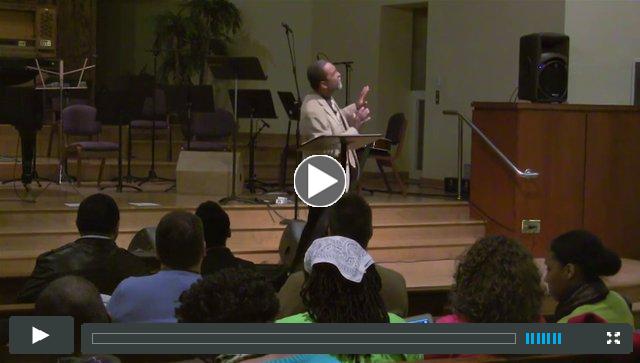 | | Nicholas Zork |
Expecting More of God
By Nicholas Zork
Today Christians around the world celebrated the audacious claim at the heart of our faith: Christ is risen! Jesus, in a single unfathomable event, forever changed not only the story of God but our human story as well. He began a chapter beyond the grave, revealed possibility in the midst of disappointment, and offered us a new way to see the world. But do we truly perceive reality through the lens of Jesus' resurrection? Over two thousand years have passed since the seminal events of that early Sunday morning. And despite our convictions about what God has done, we have learned over time to manage our expectations. The triumph of life over death, the persistence of hope in the presence of doubt, God's fulfillment of promises to us even when we do not remember or believe them; Christ's resurrection represents all of this and more. But has the story become merely a memorial to the past and not a paradigm for the present and future? There is a tendency in Adventist theology -- and especially our theology of final events -- to focus on identifying forces that oppose the cause of God. And such forces are certainly prevalent. But have we come to expect greater influence from those we suspect will harm this world than the God who is working to heal it? And do our inverted expectations fuel a fear that turns us inward, away from our Source of assurance, blinding us to the wide sphere of God's redemptive activity? As we gather each Sabbath to worship the One who we by faith boldly assert is risen from the dead, may we grow in our capacity to expect more of God. May the Spirit give us eyes to see a world in which God still works in unprecedented, unexpected, and unlikely ways. May a pessimism rooted in self-focus and xenophobia be supplanted by an optimism nourished by faith in the risen Christ. And may God give us the grace to persevere, daring to hope in the One who still brings life out of death. Share your thoughts in our Facebook dialogue.
|
Singing in a Strange Land: Worship from the Underside
Click here to watch Pedrito Maynard-Reid's presentation at the 2013 Andrews University Music and Worship Conference.[1] Maynard-Reid offers insights on the important issue of how Christian worship relates to the biblical vision of justice. After watching the video, please share your thoughts in our Facebook dialogue.
 | | "Singing in a Strange Land: Worship from the Underside" |
[1] Views expressed by all presenters are not necessarily those of the North American Division, Andrews University or event sponsors.
|
 | | David Williams |
As pastors and worship leaders, we often become consumed with writing sermons and preparing music. Yet, have you ever taken time to consider that the worship at your church communicates meaning, even theology? Understanding the theology manifest in our worship practices is vital for a thriving church.
At the recent Music and Worship Conference at Andrews University, I had the privilege of presenting a workshop, entitled: "Prejudiced Worship Theology:
Lessons from the History of Multi-Cultural Worship." Specifically, we considered the discipline of liturgical theology, which draws out implicit theology in liturgical practices, the experienced reality of the order, elements, and repeated actions (ritual) in Christian worship. This method corresponds with Ellen G. White's statement, that "modes of worship" reveal conceptions of God, the world, humanity, and salvation (The Great Controversy, 569). Norval Pease once said, "Worship reflects the theology of the worshipers" (And Worship Him, 31, 42).
We applied this methodology to two historical accounts involving the development of the independent African American church, in which racially prejudiced liturgical practices reflected profound theology on the part of all those present. The prevailing cultural and societal philosophy of white supremacy had caused white Christians to discriminate against their black brothers and sisters as to where black participants could sit in worship, and even when they could receive communion. The students of the workshop indicated that the whites implicitly maligned the character of God, suggesting that whites and blacks access God differently, and even taught that there were two saviors, one for whites and one for blacks. Black liturgical behavior demonstrated that God was no respecter of persons, and that the ground is level at the foot of the cross (for more, see Richard Allen, The Life, Experience and Labours, 13-14; and Benjamin Arnett, Proceedings of the Semi-Centenary Celebration, 16). These historical accounts provided much theological material for reflection and application to the present day. I was thrilled to learn how well this lesson was received and quickly apprehended by the workshop attendees.
We then considered how our contemporary practices should be evaluated to determine the theology implicit in them as well. Important questions were raised and applied to our current situations in leadership: Is there prejudice in your worship planning? Is your church multi-cultural? Multi-ethnic? Where do people sit? Who leads in your worship? Is there prejudice against the rich tradition of sacred music? Prejudice against singing a new song? Discrimination based on race? Gender? Age? What do your worship choices reveal, theologically?
Best practices for Adventist worship should reflect upon these pressing questions. Take time with your worship committees and worship teams to reflect upon the theology of your liturgical practices. The conversation is sure to be lively and richly rewarding. As we wrestle with these issues and seek biblical solutions, the Lord will bless our worship.
|
 | | André Reis |
La Iglesia Publica Libro Sobre Música y Adoración
Por André Reis
La editora adventista Pacific Press publicó en el mes de marzo de 2013 el libro En Espíritu y en Verdad, escrito por profesionales del área de la música, teología, psicología y medicina y editado por la Prof. Adriana Perera (Universidad Adventista de Oakwood). El libro trata de aclarar algunas de las cuestiones que surgen sobre el tema de la música adventista desde una perspectiva moderada, ni ultra-conservadora ni ultra-progresista.
Algunos de los capítulos del libro tratan de los mitos acerca de los instrumentos musicales, Elena de White y la música (especialmente el incidente de Indiana), los desafíos de la música contemporánea, los mensajes subliminales y la emoción en la adoración, entre otros puntos importantes.

El libro cierra un brecha en la actual escasez de materiales apropiados para atender a la iglesia, que desde hace décadas encuentra desafíos en la renovación de la música y la adoración. El reto de la contextualización es todavía más grande en Norteamérica donde el conflicto intergeneracional es bastante agudo. Sin embargo, el problema se ha agravado más recientemente con la publicación de libros y materiales audiovisuales en español sobre la música y adoración por parte de ciertos ministerios independientes que han tenido un impacto profundamente negativo en nuestras iglesias.
El Pr. Ernest Castillo, vice-presidente de la División Norteamericana afirmó que el liderazgo de la iglesia pretende que el libro En Espíritu y en Verdad represente el enfoque deseable para el ministerio Adventista hispano en este campo en relación a la música y adoración. Se puede ordenar el libro a la siguiente dirección: http://www.adventistbookcenter.com/in-spirit-and-in-truth-spanish.html o en su ABC local.
Tuve el privilegio de escribir dos de los capítulos del libro. En las próximas ediciones de "Best Practices for Adventist Worship", haré un pequeño resumen de ellos.
|
 | | Dannon Rampton |
To wrap up this little series on the role of design in our places of worship, I'd like to summarize three main topics to consider. If you are in the process of preparing for a renovation, taking time to process these concepts will help guide you into a design that will best facilitate the worship goals of your community.
FIRST IMPRESSIONS - Remember that the design of your space can make a powerful statement to visitors. What ideas to you want to convey to someone who walks in your doors for the first time?
VALUES - The design of your worship space should reflect what your community values in worship. What are those values, and how can the design of your space contribute to enhancing the worship experience?
FOCUS - Each element of a good design should work together to draw the focus toward a specific point or a more abstract idea. The values of your congregation will determine the focus of your design. Does each element help draw one's attention to what's most important? Do visual design elements facilitate a focus on God?
As you may have gathered by now, a successful design comes from truly understanding the biblical values of your group, and finding ways to communicate that with architectural elements and decor. If you can come to solid conclusions about what message you want to convey, someone who speaks the language of design will have an easy time translating that into a space that really enhances the experience of your congregation.
Suggest one design element you plan to consider reshaping over the coming months in our Facebook dialogue.
|
|
| To the Point |
"Our old history ends with the cross; our new history begins with the resurrection."
-Watchman Nee
A Christ-centred worship -- which is event-oriented worship -- can never be static and merely intellectual because what happens is an actual and real communication of the power and benefit of the life, death, and resurrection of Christ. Worshiping churches recognize that every gathering of worship is ultimately a praise and thanksgiving for the overthrow of evil by God in Christ. This victory not only happened two thousand years ago, but it happens today in the lives of people who bring to worship their own struggles against that evil which shatters relationships, oppresses the poor, and brings constant dislocation into life. -Robert Webber
|
|